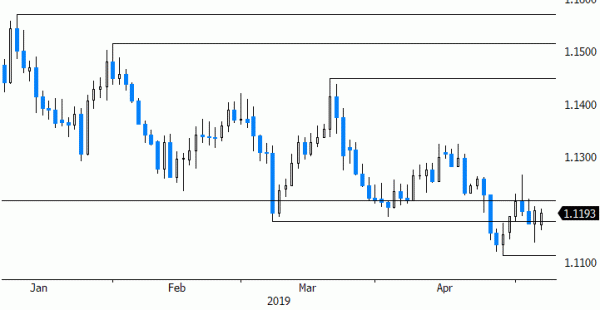- Rates: US President Trump jeopardizes US-Sino trade talks
US President Trump unexpectedly upped the ante in US-Sino trade talks by threatening to raise existing tariffs and introduce new levies on Chinese imports. China considers to walk away from this week’s scheduled talks. A risk-off wave sends core bonds higher this morning. Trade will dominate today’s second tier agenda. Volumes will be lower with UK markets closed. - Currencies: Dollar doesn’t profit from strong US payrolls nor from rising trade tensions
The dollar didn’t profit from strong US payrolls on Friday. Modest wage growth and a poor non-manufacturing ISM capped any potential USD progress. This morning, sentiment turns outright risk-off as president Trump warned on new tariffs on Chinese goods. The dollar again doesn’t profit. The US currency might lose interest rate support if tensions escalate further
The Sunrise Headlines
- US equity markets matched record highs on Friday with tech shares outperforming. Asian shares are trading in red as US-Sino trade talks are struggling. Chinese indices underperform heavily (-6%). UK markets are closed.
- US President Trump increased pressure on China by threatening amongst others to raise existing tariffs from 10% to 25% because trade negotiations are going too slowly. China considers to cancel this week’s discussions.
- UK PM May is drafting a new law that would create a custom union-style arrangement, guaranteeing no checks on goods crossing the UK-EU border, a key demand from opposition party Labour. Cross-party talks continue this week.
- China will cut the required reserve ratio by 3% for small commercial lenders that serve small firms. The cut will release 280 billion yuan of liquidity and seems to be aimed at lifting sentiment following Trump’s new threat.
- US National Security adviser John Bolton said the US will send an aircraft carrier and bomber force to the Middle East to send “a clear message to the Iranian regime”. The US is attempting to reduce Iran’s oil exports to zero.
- Portuguese Socialist PM Costa threatened to quit if a coalition of left-wing allies and centre-right opponents continued with a controversial pay deal for teachers. The coalition backed down, making it unlikely for the deal to pass.
- Today’s US economic calendar is empty. The EMU prints retail sales results for March. Italy, Spain and Sweden publish Composite/Services PMI’s. Fed’s Harker speaks today, as does outgoing ECB chief economist Peter Praet
Currencies: Dollar Doesn’t Profit From Strong US Payrolls Nor From Rising Trade Tensions
USD hardly profits from rising trade tensions
The euro outperformed on Friday, but the market reaction to the data was a bit remarkable. EUR/USD didn’t profit from a jump in EMU inflation (1.7% headline, 1.2% core), which was considered temporary. Later, US payrolls showed strong job growth, but the dollar also failed to profit as wage growth disappointed again. The US currency even lost further ground as the US non-manufacturing ISM unexpectedly dropped. (FX) markets keep the view that the dollar is at risk to lose interest rate support if US inflation stays as tame as it was of late. EUR/USD closed at 1.1198. USD/JPY finished at 111.10.
This morning, the positive (goldilocks-like) sentiment in the US on Friday is abruptly overthrown as president Trump said he might raise tariffs on Chinese good as soon as Friday. The tweets are causing doubts on a positive outcome of the US-China trade talks. Asian equities and the yuan (USD/CNY 6.78) are suffering heavy losses. AUD/USD dropped below 0.70. The yen strengthened to the USD/JPY 110.30 area, but gains eased later. The euro is holding up well. EUR/USD is still changing hands in the high 1.11 area.
Today, there few important data in the US and EMU. The focus will turn to the US-China trade war. The yen will probably outperform. The impact on EUR/USD is not that evident. The EMU economy proved very sensitive to global trade tensions. So, an escalation in the trade war might be a euro negative. At the same time, a risk off correction might lead to lower US yields (less interest rate support for the dollar). If trade tension escalate further, US president Trump might also threat to use US the dollar as weapon. As always, we keep a close eye at the EUR/JPY price action in a risk-off context. However, we have the impression that the negative impact on EUR/USD might be limited for now. The price action on Friday also suggested that the bar for sustained USD gains might be quite high. We maintain the view that the EUR/USD 1.1110 support area won’t be that easy to break.
On Friday, sterling gained further ground on headlines/rumours that the negotiations between UK government and labour might lead to an agreement on a rather soft Brexit (customs union). EUR/GBP dropped to the 0.85 area. However, comments during the weekend suggested there is still quite some distrust between the two parties. UK markets are closed today. For now, we don’t expect sterling to get additional support from investors anticipating a political agreement on Brexit.
EUR/USD: dollar doesn’t profit from strong US payrolls. Rising trade tensions this morning also provide little support fort the US currency.














